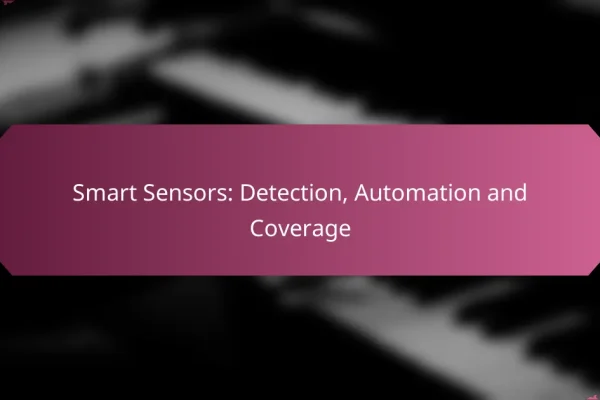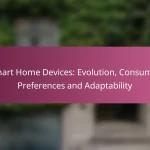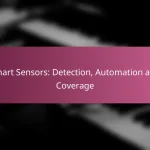What are the best smart home security devices?
The best smart home security devices combine advanced technology with user-friendly features to enhance home safety. Key options include video doorbells, security cameras, smart locks, and comprehensive security systems, each offering unique benefits and considerations.
Ring Video Doorbell
The Ring Video Doorbell allows homeowners to see and communicate with visitors remotely through a smartphone app. It features HD video, two-way audio, and motion detection alerts, making it a practical choice for monitoring entry points.
Consider the installation process, which can be done wired or wirelessly. The device typically requires a stable Wi-Fi connection and may involve a subscription for cloud storage of video footage.
Arlo Pro 4 Security Camera
The Arlo Pro 4 Security Camera offers high-resolution video and advanced night vision capabilities. It is designed for both indoor and outdoor use, providing flexibility in placement and monitoring.
This camera operates on battery power, making it easy to install without needing electrical wiring. Users should evaluate the subscription options for additional features like cloud storage and advanced AI detection.
August Smart Lock Pro
The August Smart Lock Pro enhances home security by allowing keyless entry through a smartphone app. It can be installed over existing deadbolts, making it a convenient upgrade for traditional locks.
Features include remote access, guest access management, and integration with other smart home devices. Ensure compatibility with your existing door hardware and consider the need for a Wi-Fi bridge for remote control.
Google Nest Secure
Google Nest Secure is a comprehensive home security system that includes motion sensors, door/window sensors, and a central hub. It offers seamless integration with other Google smart devices for a cohesive smart home experience.
This system is designed for easy installation and can be monitored through a smartphone app. Users should consider the subscription model for additional features like professional monitoring and extended video storage.
SimpliSafe Home Security System
SimpliSafe provides a customizable home security solution with various sensors and cameras. Its DIY installation process allows users to tailor the system to their specific needs without professional help.
SimpliSafe offers flexible monitoring plans, including options for professional monitoring or self-monitoring through the app. Evaluate the range of devices available to ensure comprehensive coverage for your home.
How do smart home devices enhance security?
Smart home devices enhance security by providing users with advanced monitoring, alert systems, and integration capabilities. These features allow homeowners to keep an eye on their property remotely, receive immediate notifications about potential threats, and connect various devices for a comprehensive security solution.
Remote monitoring capabilities
Remote monitoring allows homeowners to view live feeds from security cameras and access their smart doorbells from anywhere using a smartphone or tablet. This capability is crucial for keeping tabs on your property while away, whether for work or vacation.
Many systems offer cloud storage options, enabling users to review recorded footage at any time. When selecting a device, consider features like video quality, storage duration, and whether the service requires a subscription fee.
Real-time alerts and notifications
Real-time alerts notify users instantly about security breaches, such as unauthorized entry or unusual activity detected by motion sensors. These notifications can be sent via mobile app, SMS, or email, ensuring that homeowners are always informed.
To maximize effectiveness, choose devices that allow customization of alert settings. This way, you can filter out non-critical notifications, such as routine movements, while still being alerted to genuine threats.
Integration with other smart devices
Smart home security systems can integrate with other devices, such as smart locks, lights, and alarms, creating a cohesive security network. This integration allows for automated responses, like turning on lights when motion is detected or locking doors remotely.
When considering integration, ensure that devices are compatible with each other and can be managed through a single app or platform. This simplifies control and enhances the overall security experience.
What features should I look for in smart security devices?
When selecting smart security devices, prioritize features that enhance safety and usability. Key aspects include video quality, audio functionality, and compatibility with other smart home systems.
Video quality and resolution
Video quality is crucial for identifying intruders and monitoring your property effectively. Look for devices that offer at least 1080p resolution, as this provides clear images during both day and night. Some advanced models may even support 4K resolution, which can be beneficial for larger areas.
Consider the field of view as well; devices with a wider angle can cover more ground. Many cameras offer features like digital zoom or pan-tilt-zoom (PTZ) capabilities, allowing you to adjust the view remotely for better surveillance.
Two-way audio functionality
Two-way audio allows you to communicate with visitors or deter intruders directly through your smart security device. This feature is particularly useful for doorbell cameras, enabling you to speak with delivery personnel or visitors without opening the door.
Ensure the device has clear audio quality and low latency for effective communication. Some models may also include noise cancellation features, which can enhance the clarity of conversations.
Smart home compatibility
Compatibility with existing smart home systems is essential for seamless integration and control. Check if the security device works with popular platforms like Amazon Alexa, Google Assistant, or Apple HomeKit, allowing you to manage devices through a single app or voice commands.
Additionally, consider whether the device can connect with other security features, such as motion sensors or alarms, to create a comprehensive security network. This integration can enhance overall functionality and provide a more cohesive user experience.
How do smart home security devices compare in pricing?
Smart home security devices vary significantly in pricing based on features, brand, and installation options. Generally, basic systems start in the low hundreds of USD, while comprehensive setups can exceed a thousand dollars, depending on the technology and services included.
Ring vs. Arlo pricing
Ring and Arlo offer competitive pricing for their smart home security devices. Ring’s basic video doorbell starts around $100, while Arlo’s equivalent may range from $150 to $200, depending on features like video quality and storage options. Subscription plans for cloud storage can add $3 to $15 monthly for both brands.
When considering overall costs, it’s essential to factor in additional equipment such as cameras and sensors, which can increase the total investment. Both brands often provide discounts for bundled products, making it worthwhile to explore package deals.
SimpliSafe vs. Google Nest pricing
SimpliSafe offers a range of security packages starting from about $200, while Google Nest systems typically begin around $300. SimpliSafe is known for its no-contract monitoring plans, which can be appealing for budget-conscious consumers, while Google Nest often includes advanced features like facial recognition and integration with other smart home devices.
Monthly monitoring fees for SimpliSafe can range from $15 to $25, whereas Google Nest’s plans may be slightly higher, reflecting its premium features. Evaluating the long-term costs associated with monitoring services is crucial when choosing between these two options.
Cost of installation services
Installation costs for smart home security devices can vary widely based on the complexity of the system and the provider. Professional installation typically ranges from $100 to $300, depending on the number of devices and the time required for setup. Some brands, like SimpliSafe, offer DIY options that can save on installation fees.
When opting for professional installation, ensure to inquire about any additional fees for equipment or ongoing service. For those comfortable with technology, DIY installations can be a cost-effective alternative, often supported by online tutorials and customer service assistance.
What are the top brands for smart home security devices?
The leading brands for smart home security devices include Amazon Ring, Google Nest, and Arlo Technologies. Each brand offers unique features and capabilities that cater to different security needs and preferences.
Amazon Ring
Amazon Ring is well-known for its video doorbells and security cameras that provide real-time monitoring and alerts. The devices integrate seamlessly with Amazon Alexa, allowing for voice control and easy access to live feeds.
When considering Ring, pay attention to its subscription plans, which offer features like cloud storage for recorded footage. The basic plan is often affordable, but additional features may require higher-tier subscriptions.
Google Nest
Google Nest offers a range of smart security products, including indoor and outdoor cameras, doorbells, and alarm systems. These devices are designed to work within the Google ecosystem, providing a user-friendly experience through the Google Home app.
One key advantage of Nest devices is their advanced AI features, which can differentiate between people, pets, and objects. This can reduce false alarms and enhance security monitoring.
Arlo Technologies
Arlo Technologies specializes in high-definition security cameras and smart home security systems. Their products are known for excellent video quality and features like night vision and two-way audio.
Arlo offers both free and subscription-based plans for cloud storage, making it flexible for users with varying needs. Consider the battery life and installation requirements, as some models may need professional installation for optimal performance.




